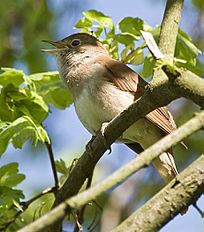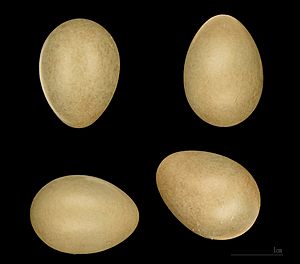Nightingale facts for kids
Quick facts for kids Nightingale |
|
|---|---|
 |
|
| Conservation status | |
| Scientific classification | |
| Kingdom: | |
| Phylum: | |
| Class: | |
| Order: | |
| Family: | |
| Genus: |
Luscinia
|
| Binomial name | |
| Luscinia megarhynchos |
|
The nightingale (scientific name: Luscinia megarhynchos) is a small, plain brown bird. It is also known as the rufous nightingale or common nightingale. It's famous for its incredibly beautiful and loud song, which it often sings at night.
Nightingales used to be grouped with the thrush family. However, scientists now place them with a group of birds called chats, which often live closer to the ground.
Contents
Where Nightingales Live and Travel
Nightingales are migratory birds. This means they travel long distances between their summer homes and their winter homes. They spend their summers breeding in forests and bushy areas across Europe and southwest Asia. When winter arrives, they fly south to Africa.
Nightingales are quite particular about where they choose to live and raise their young. They like places that are:
- Not too high up (usually below 200 meters above sea level).
- Warm enough, with average temperatures above 14°C during the growing season.
- Sunny, with more than 20 days a year where temperatures are above 25°C.
- Not too rainy, with less than 750mm of rain each year.
- Open, without a completely closed tree canopy, so some sunlight can reach the ground.
They build their nests on the ground, often hidden within or next to thick bushes.
What Nightingales Look Like
The nightingale is a bit bigger than a robin. It measures about 15 to 16.5 centimeters (about 6 inches) long. Its back and wings are plain brown, but it has a reddish-brown tail. Its belly is a lighter color, from buff to white. Both male and female nightingales look very similar.
Why Nightingales Sing at Night
Nightingales get their name because they frequently sing at night, as well as during the day. The name "nightingale" has been used for over 1,000 years! It comes from an old Anglo-Saxon word meaning "night songstress." For a long time, people thought the female bird was the one singing, but it's actually the male nightingale that sings.
The nightingale's song is very loud and impressive. It includes a wide variety of whistles, trills, and gurgling sounds. You notice its song especially at night because most other birds are quiet then.
Only male nightingales who haven't found a mate yet sing regularly at night. This night singing helps them attract a partner. Singing loudly at dawn, just before sunrise, is important for defending their territory from other birds. Nightingales that live in or near cities often sing even louder to make sure their song can be heard over the background noise.
A special part of the nightingale's song is a loud, rising whistle that builds up to a peak. This sound is not found in the song of its close relative, the thrush nightingale. Nightingales also have an alarm call that sounds a bit like a frog.
Images for kids
See also
 In Spanish: Ruiseñor común para niños
In Spanish: Ruiseñor común para niños






